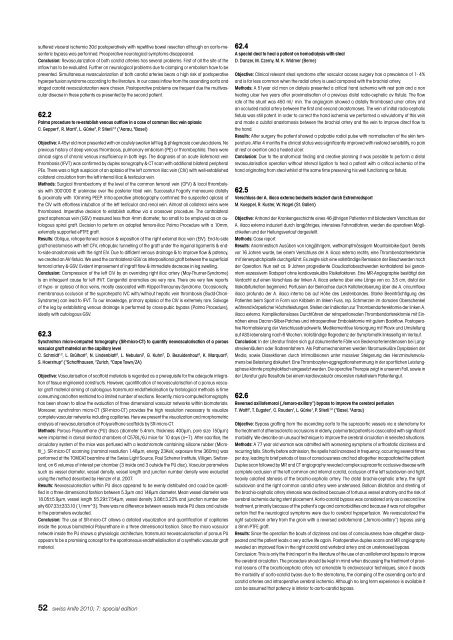Anorectal Manometry in 3D NEW! - Swiss-knife.org
Anorectal Manometry in 3D NEW! - Swiss-knife.org
Anorectal Manometry in 3D NEW! - Swiss-knife.org
Create successful ePaper yourself
Turn your PDF publications into a flip-book with our unique Google optimized e-Paper software.
suffered visceral ischemia 30d postoperatively with repetitive bowel resection although an aorto-mesenteric<br />
bypass was performed. Preoperative neurological symptoms disappeared.<br />
Conclusion: Revascularization of both carotid arteries has several problems. First of all the site of the<br />
<strong>in</strong>flow has to be evaluated. Further on neurological problems due to clamp<strong>in</strong>g or embolism have to be<br />
prevented. Simultaneous revascularization of both carotid arteries bears a high risk of postoperative<br />
hyperperfusion syndrome accord<strong>in</strong>g to the literature. In our cases <strong>in</strong>flow from the ascend<strong>in</strong>g aorta and<br />
staged carotid revascularization were chosen. Postoperative problems are frequent due the multivascular<br />
disease <strong>in</strong> these patients as presented by the second patient.<br />
62.2<br />
Palma procedure to re-establish venous outflow <strong>in</strong> a case of common Iliac ve<strong>in</strong> aplasia<br />
C. Geppert 1 , R. Marti 1 , L. Gürke 2 , P. Stierli 1,2 ( 1 Aarau, 2 Basel)<br />
Objective: A 45yr old man presented with an acutely swollen left leg & phlegmasia coerulea dolens. No<br />
previous history of deep venous thrombosis, pulmonary embolism (PE) or thrombophilia. There were<br />
cl<strong>in</strong>ical signs of chronic venous <strong>in</strong>sufficiency <strong>in</strong> both legs. The diagnosis of an acute iliofemoral ve<strong>in</strong><br />
thrombosis (IFVT) was confirmed by duplex sonography & CT scan with additional bilateral peripheral<br />
PEs. There was a high suspicion of an aplasia of the left common iliac ve<strong>in</strong> (CIV) with well-established<br />
collateral circulation from the left <strong>in</strong>ternal iliac & testicular ve<strong>in</strong>.<br />
Methods: Surgical thrombectomy at the level of the common femoral ve<strong>in</strong> (CFV) & local thrombolysis<br />
with 300’000 IE urok<strong>in</strong>ase over the posterior tibial ve<strong>in</strong>. Successful Fogarty manoeuvre distally<br />
& proximally with 10mmHg PEEP. Intra-operative phlebography confirmed the suspected aplasia of<br />
the CIV with effortless <strong>in</strong>tubation of the left testicular and renal ve<strong>in</strong>. Almost all collateral ve<strong>in</strong>s were<br />
thrombosed. Imperative decision to establish outflow via a crossover procedure. The contralateral<br />
great saphenous ve<strong>in</strong> (GSV) measured less than 4mm diameter, too small to be employed as an autologous<br />
spiral graft. Decision to perform an adapted femoro-iliac Palma Procedure with a 10mm,<br />
externally supported ePTFE graft.<br />
Results: Oblique, retroperitoneal <strong>in</strong>cision & exposition of the right external iliac ve<strong>in</strong> (EIV). End-to-side<br />
graft-anastomosis with left CFV, retropubic tunnell<strong>in</strong>g of the graft under the <strong>in</strong>gu<strong>in</strong>al ligaments & endto-side-anastomosis<br />
with the right EIV. Due to diffident venous dra<strong>in</strong>age & to improve flow & patency,<br />
we created an AV-fistula. We used the contralateral GSV as <strong>in</strong>terpositional graft between the superficial<br />
femoral artery & GSV. Evident improvement of <strong>in</strong>graft flow & immediate decrease <strong>in</strong> leg swell<strong>in</strong>g.<br />
Conclusion: Compression of the left CIV by an overrid<strong>in</strong>g right iliac artery (May-Thurner-Syndrome)<br />
is an <strong>in</strong>frequent cause for left IFVT. Congenital anomalies are very rare. There are very few reports<br />
of hypo- or aplasia of iliac ve<strong>in</strong>s, mostly associated with Klippel-Trenaunay-Syndrome. Occasionally,<br />
membranous occlusion of the suprahepatic IVC with/without hepatic ve<strong>in</strong> thrombosis (Budd-Chiari-<br />
Syndrome) can lead to IFVT. To our knowledge, primary aplasia of the CIV is extremely rare. Salvage<br />
of the leg by establish<strong>in</strong>g venous dra<strong>in</strong>age is performed by cross-pubic bypass (Palma Procedure),<br />
ideally with autologous GSV.<br />
62.3<br />
Synchrotron micro-computed tomography (SR-micro-CT) to quantify neovascularisation of a porous<br />
vascular graft material on the capillary level<br />
C. Schmidt 1,2 , L. Brülhart 2 , N. L<strong>in</strong>denblatt 2 , L. Nebuloni 2 , G. Kuhn 2 , D. Bezuidenhout 3 , K. Marquart 2 ,<br />
S. Hoerstrup 2 ( 1 Schaffhausen, 2 Zurich, 3 Cape Town/ZA)<br />
Objective: Vascularisation of scaffold materials is regarded as a prerequisite for the adequate <strong>in</strong>tegration<br />
of tissue eng<strong>in</strong>eered constructs. However, quantification of neovascularisation of a porous vascular<br />
graft material aim<strong>in</strong>g at autologous transmural endothelialisation by histological methods is time<br />
consum<strong>in</strong>g and often restricted to a limited number of sections. Recently, micro-computed tomography<br />
has been shown to allow the evaluation of three dimensional vascular networks with<strong>in</strong> biomaterials.<br />
Moreover, synchrotron micro-CT (SR-micro-CT) provides the high resolution necessary to visualize<br />
complete vascular networks <strong>in</strong>clud<strong>in</strong>g capillaries. Here we present the visualization and morphometric<br />
analysis of neovascularisation of Polyurethane scaffolds by SR-micro-CT.<br />
Methods: Porous Polyurethane (PU) discs (diameter 5.4mm, thickness 400μm, pore size 150μm)<br />
were implanted <strong>in</strong> dorsal sk<strong>in</strong>fold chambers of C57BL/6J mice for 10 days (n=7). After sacrifice, the<br />
circulatory system of the mice was perfused with a leadchromate conta<strong>in</strong><strong>in</strong>g silicone rubber (Microfil_).<br />
SR-micro-CT scann<strong>in</strong>g (nom<strong>in</strong>al resolution 1.48μm, energy 23KeV, exposure time 360ms) was<br />
performed at the TOMCAT beaml<strong>in</strong>e at the <strong>Swiss</strong> Light Source, Paul Scherrer Institute, Villigen, Switzerland,<br />
on 6 volumes of <strong>in</strong>terest per chamber (3 <strong>in</strong>side and 3 outside the PU disc). Vascular parameters<br />
such as vessel diameter, vessel density, vessel length and junction number density were evaluated<br />
us<strong>in</strong>g the method described by He<strong>in</strong>zer et al. 2007.<br />
Results: Neovascularisation with<strong>in</strong> PU discs appeared to be evenly distributed and could be quantified<br />
<strong>in</strong> a three dimensional fashion between 5.3μm and 146μm diameter. Mean vessel diameter was<br />
18.05±5.9μm, vessel length 55.29±7.54μm, vessel density 3.86±3.22% and junction number density<br />
607.33±333.10 [1/mm^3]. There was no difference between vessels <strong>in</strong>side PU discs and outside<br />
<strong>in</strong> the parameters evaluated.<br />
Conclusion: The use of SR-micro-CT allows a detailed visualization and quantification of capillaries<br />
<strong>in</strong>side the porous biomaterial Polyurethane <strong>in</strong> a three dimensional fashion. S<strong>in</strong>ce the micro vascular<br />
network <strong>in</strong>side the PU shows a physiologic architecture, transmural neovascularisation of porous PU<br />
appears to be a promis<strong>in</strong>g concept for the spontaneous endothelialisation of a synthetic vascular graft<br />
material.<br />
52 swiss <strong>knife</strong> 2010; 7: special edition<br />
62.4<br />
A special deal to heal a patient on hemodialysis with steal<br />
D. Danzer, M. Czerny, M. K. Widmer (Berne)<br />
Objective: Cl<strong>in</strong>ical relevant steal syndrome after vascular access surgery has a prevalence of 1- 4%<br />
and is far less common when the radial artery is used compared with the brachial artery.<br />
Methods: A 51year old man on dialysis presented a critical hand ischemia with rest pa<strong>in</strong> and a non<br />
heal<strong>in</strong>g ulcer two years after proximalisation of a previous distal radio-cephalic av fistula. The flow<br />
rate of the shunt was 450 ml/ m<strong>in</strong>. The angiogram showed a distally thrombosed ulnar artery and<br />
an occluded radial artery between the first and second anastomoses. The ve<strong>in</strong> of <strong>in</strong>itial radio-cephalic<br />
fistula was still patent. In order to correct the hand ischemia we performed a valvulotomy of this ve<strong>in</strong><br />
and made a cubital anastomosis between the brachial artery and the ve<strong>in</strong> to improve direct flow to<br />
the hand.<br />
Results: After surgery the patient showed a palpable radial pulse with normalisation of the sk<strong>in</strong> temperature.<br />
After 4 months the cl<strong>in</strong>ical status was significantly improved with restored sensibility, no pa<strong>in</strong><br />
at rest or exertion and a healed ulcer.<br />
Conclusion: Due to the anatomical f<strong>in</strong>d<strong>in</strong>g and creative plann<strong>in</strong>g it was possible to perform a distal<br />
revascularisation operation without <strong>in</strong>terval ligation to heal a patient with a critical ischemia of the<br />
hand orig<strong>in</strong>at<strong>in</strong>g from steal whilst at the same time preserv<strong>in</strong>g his well function<strong>in</strong>g av fistula.<br />
62.5<br />
Verschluss der A. iliaca externa beidseits <strong>in</strong>duziert durch Extremradsport<br />
M. Koeppel, R. Kuster, W. Nagel (St. Gallen)<br />
Objective: Anhand der Krankengeschichte e<strong>in</strong>es 46-jährigen Patienten mit bilateralem Verschluss der<br />
A. iliaca externa <strong>in</strong>duziert durch langjähriges, <strong>in</strong>tensives Fahrradfahren, werden die operativen Möglichkeiten<br />
und der Heilungsverlauf dargestellt.<br />
Methods: Case report.<br />
Results: Anamnestisch Ausüben von langjährigem, wettkampfmässigem Mounta<strong>in</strong>bike-Sport. Bereits<br />
vor 16 Jahren wurde, bei e<strong>in</strong>em Verschluss der A. iliaca externa rechts, e<strong>in</strong>e Thrombendarterektomie<br />
mit Venenpatchplastik durchgeführt. Es zeigte sich e<strong>in</strong>e vollständige Remission der Beschwerden nach<br />
der Operation. Nun seit ca. 9 Jahren progrediente Claudicatiobeschwerden kontralateral bei genanntem<br />
exzessivem Radsport ohne kardiovaskuläre Risikofaktoren. E<strong>in</strong>e MR-Angiographie bestätigt den<br />
Verdacht auf e<strong>in</strong>en Verschluss der l<strong>in</strong>ken A. iliaca externa über e<strong>in</strong>e Länge von ca. 3,5 cm, distal der<br />
Iliakalbifurkation beg<strong>in</strong>nend. Perfusion der Be<strong>in</strong>achse durch Kollateralisierung über die A. circumflexa<br />
iliaca profunda der A. iliaca <strong>in</strong>terna bis auf Höhe des Leistenbandes. Starke Bee<strong>in</strong>trächtigung des<br />
Patienten beim Sport <strong>in</strong> Form von Kribbeln im l<strong>in</strong>ken Fuss, rsp. Schmerzen im dorsalen Oberschenkel<br />
während körperlicher Höchstleistungen. Stellen der Indikation zur Thrombendarterektomie der l<strong>in</strong>ken A.<br />
iliaca externa. Komplikationsloses Durchführen der retroperitonealen Thrombendarterektomie mit E<strong>in</strong>nähen<br />
e<strong>in</strong>es Dacron-Silber-Patches und <strong>in</strong>traoperativer Embolektomie mit gutem Backflow. Postoperative<br />
Normalisierung der Verschlussdruckwerte. Medikamentöse Vers<strong>org</strong>ung mit Plavix und Umstellung<br />
auf ASS lebenslang nach 6 Wochen. Vollständige Regredienz der Symptomatik l<strong>in</strong>ksseitig im Verlauf.<br />
Conclusion: In der Literatur f<strong>in</strong>den sich gut dokumentierte Fälle von Beckenarterienstenosen bei Langstreckenläufern<br />
oder Radrennfahrern. Als Pathomechanismen werden fibromuskuläre Dysplasien der<br />
Media, sowie Dissektionen durch Intimaläsionen unter massiver Steigerung des Herzm<strong>in</strong>utenvolumens<br />
bei Belastung diskutiert. E<strong>in</strong>e Thrombozyten-aggregationshemmung <strong>in</strong> der sportlichen Leistungsphase<br />
könnte prophylaktisch e<strong>in</strong>gesetzt werden. Die operative Therapie zeigt <strong>in</strong> unserem Fall, sowie <strong>in</strong><br />
der Literatur gute Resultate bei e<strong>in</strong>em kardiovaskulär ansonsten risikofreiem Patientengut.<br />
62.6<br />
Reversed axillofemoral („femoro-axillary“) bypass to improve the cerebral perfusion<br />
T. Wolff 1 , T. Eugster 1 , C. Rouden 1 , L. Gürke 1 , P. Stierli 1,2 ( 1 Basel, 2 Aarau)<br />
Objective: Bypass graft<strong>in</strong>g from the ascend<strong>in</strong>g aorta to the supraaortic vessels via a sternotomy for<br />
the treatment of atherosclerotic occlusions <strong>in</strong> elderly, polymorbid patients is associated with significant<br />
morbidity. We describe an unusual technique to improve the cerebral circulation <strong>in</strong> selected situations.<br />
Methods: A 77 year old woman was admitted with worsen<strong>in</strong>g symptoms of orthostatic dizz<strong>in</strong>ess and<br />
recurr<strong>in</strong>g falls. Shortly before admission, the spells had <strong>in</strong>creased <strong>in</strong> frequency, occurr<strong>in</strong>g several times<br />
per day, lead<strong>in</strong>g to brief periods of loss of consciousness and had altogether <strong>in</strong>capacitated the patient.<br />
Duplex scan followed by MR and CT angiography revealed complex supraaortic occlusive disease with<br />
complete occlusion of the left common and <strong>in</strong>ternal carotid, occlusion of the left subclavian and tight,<br />
heavily calcified stenosis of the brachio-cephalic artery. The distal brachio-cephalic artery, the right<br />
subclavian and the right common carotid artery were unstenosed. Balloon dilatation and stent<strong>in</strong>g of<br />
the brachio-cephalic artery stenosis was decl<strong>in</strong>ed because of tortuous vessel anatomy and the risk of<br />
cerebral ischemia dur<strong>in</strong>g stent placement. Aorto-carotid bypass was considered only as a second l<strong>in</strong>e<br />
treatment, primarily because of the patient‘s age and comorbidities and because it was not altogether<br />
certa<strong>in</strong> that the neurological symptoms were due to cerebral hypoperfusion. We revascularized the<br />
right subclavian artery from the gro<strong>in</strong> with a reversed axillofemoral („femoro-axillary“) bypass us<strong>in</strong>g<br />
a 8mm PTFE graft.<br />
Results: S<strong>in</strong>ce the operation the bouts of dizz<strong>in</strong>ess and loss of consciousness have altogether disappeared<br />
and the patient leads a very active life aga<strong>in</strong>. Postoperative duplex scans and MR angiography<br />
revealed an improved flow <strong>in</strong> the right carotid and vertebral artery and an unstenosed bypass.<br />
Conclusion: This is only the third report <strong>in</strong> the literature of the use of an axillofemoral bypass to improve<br />
the cerebral circulation. The procedure should be kept <strong>in</strong> m<strong>in</strong>d when discuss<strong>in</strong>g the treatment of proximal<br />
lesions of the brachiocephalic artery not amenable to endovascular techniques, s<strong>in</strong>ce it avoids<br />
the morbidity of aorto-carotid byass due to the sternotomy, the clamp<strong>in</strong>g of the ascend<strong>in</strong>g aorta and<br />
carotid arteries and <strong>in</strong>traoperative cerebral ischemia. Although no long term experience is available it<br />
can be assumed that patency is <strong>in</strong>ferior to aorto-carotid bypass.
















